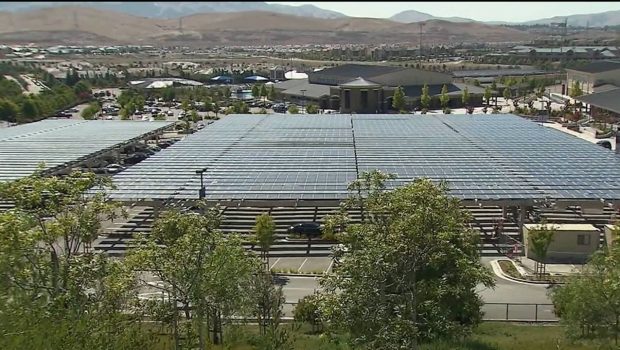How technology is shaping climate change solutions
LOS ANGELES — Climate Week NYC was back after a two-year hiatus from the COVID-19 pandemic.
As the nation transitions to a future with less greenhouse gas emissions, it will get there with the help of climate tech and historic climate investments, thanks to the Inflation Reduction Act that has $369 billion in climate provisions that ushers in a new era of tax credits.
While Climate Week was having a moment in the Big Apple, there was enthusiasm here in Southern California.
Let’s begin with the solar industry, as RE+ took place all week at the Anaheim Convention Center. RE+ is the largest event in North America for solar, as well as the growing clean energy industry.
Solar supplies more than 20% of California’s electricity today, but it must play a bigger role if the state is to reach net zero.
While solar has been at the beginning of the renewable energy frontier, solar company Enphase’s spokesperson Andy Newbold says products like the IQ8 micro-inverter are a game-changer, as it enables solar panels to power a home during a grid outage without having a backup battery storage supply.
“When the grid goes down, they can still use that solar energy to power their homes,” said Newbold.
Solar may be further along in the renewable energy space, but burgeoning alternative energy sources like wave energy could become part of Los Angeles’ power portfolio.
This fall, sea wave energy technology company Eco Wave Power will arrive on site at AltaSea at the Port of LA.
The wave power technology will be on display to prove it’s a viable renewable energy solution that could be installed at the port and could power the surrounding communities.
Rep. Nanette Barragán, who represents California’s 44th District, says the importance of having new emerging technologies like Eco Wave at AltaSea will be key to understanding how energy produced by waves can be scaled up and connect to the grid as a power source.
“When we see projects like Eco Wave that have been tested and have worked in places like Israel and Gibraltar, we’re excited to bring them to San Pedro at AltaSea,” said Barragán.
The transportation sector is one of the largest contributors to human-caused greenhouse gas emissions that are driving the global warming trend observed since the mid-20th century.
However, this sector is already well underway in transitioning to clean vehicles, especially with the boost from the Biden administration earlier this year, announcing new standards for a National EV Charging Network.
The idea is to have accessibility to EV charging as easily as we do now with gas stations.
The first part of the nationwide goal is to have EV charging off highway exits, enabling drivers to rid their charging anxiety as they travel the country coast to coast across 53,000 miles of highways.
Earlier this month, the federal government approved the first 35 state plans to build out their EV charging infrastructure.
Private companies like Blink Charging plan to be utilized in the new nationwide network. Mike Battaglia, Blink’s senior vice president of sales and business development, says they’ll use renewable power sources like solar and battery storage to help alleviate stress on the grid during peak demand.
“Obviously in California, we have things like rolling brownouts and blackouts and things,” said Battaglia. “So there’s going to have to be some innovation, and that innovation is going to come from the utility companies installing additional power stations and ensuring that the grid can kind of expand from there.”
Another large contributor to global emissions is our built environment — the places we live, work, eat, play and learn in.
Buildings are estimated to contribute around 40% of global emissions, which is why the U.S. Green Building Council promotes energy efficiency and environmental responsibility through various certifications like Leadership in Energy & Environmental Design.
Ben Stapleton, the USGBG-Los Angeles chapter’s executive director, says that as LA’s energy grid becomes more renewable, electrifying our homes and switching out old gas-powered appliances will allow emissions to be removed from the atmosphere and have a cleaner environment in our homes.
“We’re at a place where, if we can make our homes operate more efficiently, if we can reduce our operating costs and our utility bills, that increases the affordability for us in homes long term,” said Stapleton. “And there’s also this great opportunity to create more localized jobs, opportunity to improve our housing. We have a huge issue right now with housing shortages.”
While tech is an integral piece for climate solutions, agtech and plant-based innovation and products experienced a renewed wave of interest during Climate Week.
Elysabeth Alfano, CEO of VegTech Invest and plant-based business consultant, says companies are focused on innovating to replace animals with clean, delicious and efficient proteins for sustainable consumption — and the products on store shelves now are catching on.
“Plant-based products have a 62% household penetration,” said Alfano. “So they are already in more than half of the American households, according to the Plant Based Foods Association. But Bloomberg thinks plant-based products will be a $162 billion industry by 2030, and Boston Consulting Group says it will be $290 billion by 2035.”
With the United Nations projecting that the worldwide population will hit 8 billion later this year, growing population numbers put an immense demand on food and resources like energy and water, which food production requires.
Climate change is expected to contribute to extreme weather events like drought and floods, which threaten crops. Given this, coupled with the meat and dairy industries as high sources of carbon dioxide and methane, we may need to be open to a future of adding alternative proteins to our plates.








Gloss